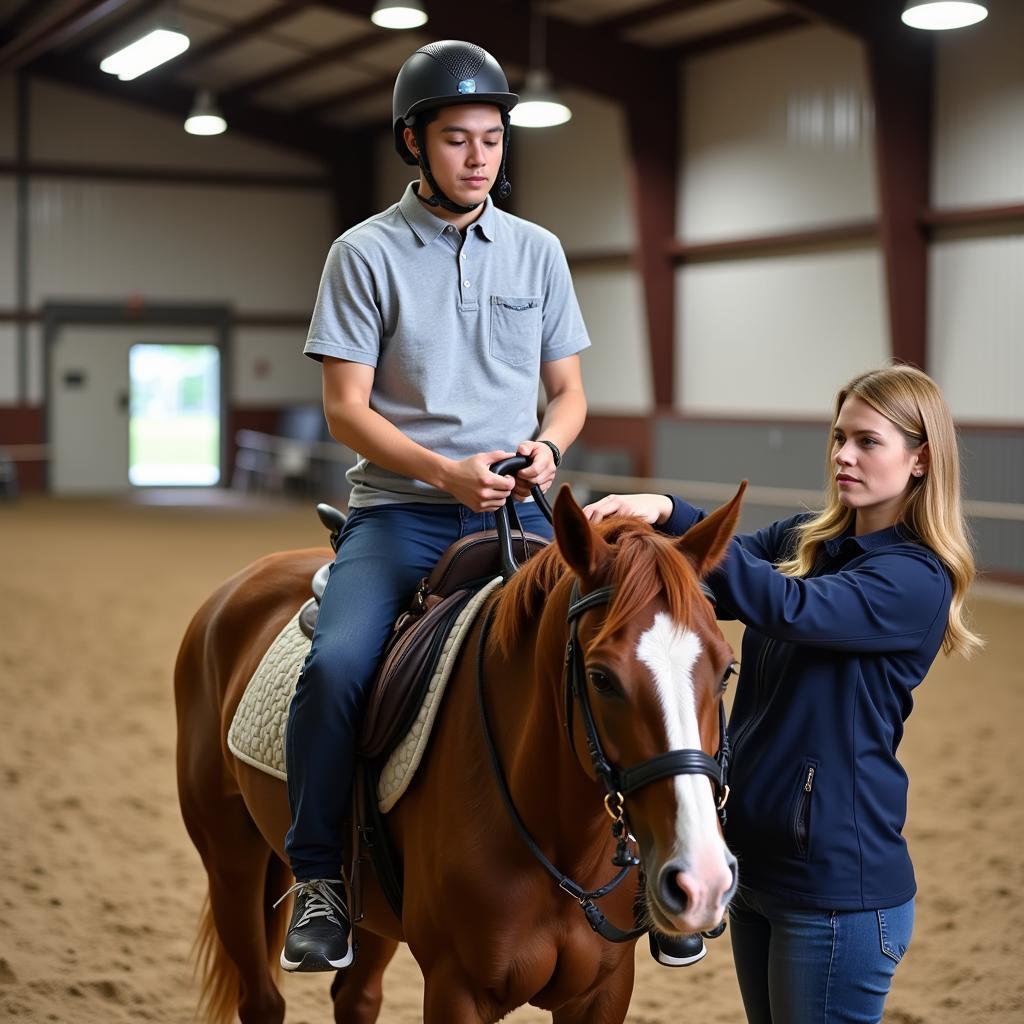Walk On Horse Therapy, also known as equine-assisted therapy, is a unique approach to mental and physical rehabilitation that leverages the powerful connection between humans and horses. This therapy offers a wide range of benefits, from improving balance and coordination to boosting emotional well-being and self-confidence. Let’s delve into the world of walk on horse therapy and explore its transformative potential.
Understanding Walk On Horse Therapy
Walk on horse therapy involves a variety of activities centered around interacting with horses. These activities might include grooming, leading, and riding the horse, but the core focus is on the therapeutic relationship that develops between the individual and the horse. The horse’s gentle nature, combined with its rhythmic movement, creates a calming and therapeutic environment.
Benefits of Walk On Horse Therapy
The benefits of walk on horse therapy extend to a wide range of physical, cognitive, and emotional challenges. Physically, the rhythmic movement of the horse helps improve balance, coordination, and muscle strength. Cognitively, it enhances focus, memory, and problem-solving skills. Emotionally, interacting with horses can reduce anxiety, boost self-esteem, and foster a sense of connection and trust.
- Improves balance and coordination
- Strengthens core muscles
- Enhances focus and attention
- Reduces anxiety and stress
- Boosts self-esteem and confidence
 Walk on horse therapy for physical benefits
Walk on horse therapy for physical benefits
Who Can Benefit from Walk On Horse Therapy?
Walk on horse therapy can benefit individuals of all ages and abilities, from children with developmental disabilities to adults recovering from stroke or trauma. It’s been shown to be particularly effective for individuals with:
- Cerebral palsy
- Autism spectrum disorder
- Down syndrome
- Traumatic brain injuries
- Post-traumatic stress disorder
- Anxiety and depression
 Walk on horse therapy for children with autism
Walk on horse therapy for children with autism
Finding a Qualified Walk On Horse Therapy Program
When choosing a walk on horse therapy program, it’s crucial to ensure that it’s run by qualified professionals. Look for programs that are certified by reputable organizations and staffed by therapists with experience in equine-assisted therapy.
- Certified therapists
- Safe and well-maintained facilities
- Individualized treatment plans
- Horses suitable for therapy
What to Expect During a Walk On Horse Therapy Session
A typical walk on horse therapy session might involve grooming the horse, leading the horse through an obstacle course, or engaging in mounted exercises. The therapist will tailor the activities to the individual’s specific needs and goals. The focus is always on creating a positive and supportive environment where the individual can connect with the horse and experience the therapeutic benefits of the interaction.
“The beauty of walk on horse therapy lies in the unique bond that forms between the horse and the individual,” says Dr. Sarah Miller, a leading equine therapist. “It’s a powerful connection that can facilitate healing on multiple levels.”
 Walk on horse therapy mounted exercises
Walk on horse therapy mounted exercises
“Horses are incredibly perceptive animals,” adds John Davis, a certified equine therapist with over 20 years of experience. “They can sense and respond to human emotions in a way that can be deeply therapeutic.”
Conclusion: Embracing the Healing Power of Horses
Walk on horse therapy is a powerful and effective therapeutic modality that can benefit individuals of all ages and abilities. By leveraging the unique connection between humans and horses, this therapy can facilitate physical, cognitive, and emotional healing. If you’re looking for a unique and rewarding therapeutic experience, walk on horse therapy may be the answer.
FAQ
- Is walk on horse therapy covered by insurance? It depends on the insurance plan and the specific therapy program.
- What should I wear to a walk on horse therapy session? Comfortable clothing and closed-toe shoes are recommended.
- Are there any age restrictions for walk on horse therapy? No, individuals of all ages can benefit.
- Do I need any prior experience with horses? No prior experience is necessary.
- How long does a walk on horse therapy session typically last? Sessions typically last between 30 and 60 minutes.
- Is walk on horse therapy safe? Yes, when conducted by qualified professionals in a safe environment.
- How often should I attend walk on horse therapy sessions? The frequency of sessions will be determined by your therapist based on your individual needs.
For further information on related topics, please explore our articles on equine-assisted learning and therapeutic riding.
When you need support, please contact Phone: 0772127271, Email: [email protected] Or visit us at: QGM2+WX2, Vị Trung, Vị Thuỷ, Hậu Giang, Việt Nam. We have a 24/7 customer service team.